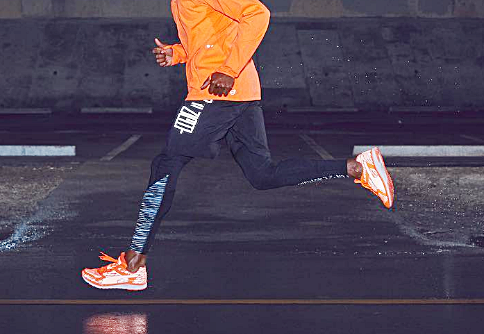Your running balance often determines how well you can stave off injury. Good balance for running involves the neuromuscular system’s ability to maintain adequate body balance based on information from the outside (i.e. the periphery). The best possible way to improve body balance during running is to run in a shoe that allows you to feel the ground, running barefoot is even better.
When you are learning a new running technique, such as forefoot running, you can’t afford to be unbalanced via running in a shoe that is racking to your neuromuscular system. This is why super think cushioned running shoes are unfavorable during the beginning stages of learning forefoot running.
Barefoot and minimalist running is leaving a good track-record at helping runners learn forefoot running with greater dynamic balance control as compared with cushioned running shoes. Sadly, reports suggests that running in ultra-thick cushioned heeled running shoes may increase external loads because all this under-foot cushioning may complicate landing stability, and because of this, the upper body position, which is also known as the center of mass, may change, making it more mechanically demanding for the foot/ankle complex to keep good balance.

Running Shoes for Support Actually Impairs Balance
Runners who wear running shoes for support, that contain motion control features and lots of cushioning, have a much higher balance failure frequency rating than runners who run barefoot or in thin, flat, less cushioned footwear.
A study by Robbins et al. concluded that running support shoes that have softer, thicker midsoles were associated with a higher perception of comfort, but also a significantly higher balance failure frequency rating in runners.
- Interestingly, previous reports have shown that running shoes with thinner, harder midsoles were just as comfortable, but provided better landing stability during running
In their study, the researchers found that participants who switched from thin running shoes to thick cushioned running shoes had a 35% increase in balance failure frequency rating. Participants who switched from hard to soft midsole running shoes had a 77% increase in balance failure frequency rating, suggesting that cushioned running shoes invites more injury than thinner ones.
How Would This Affect Performance?
Based on their data, the researchers concluded that thin running shoes are stability optimized shoes for runners and asserted that performance could be improved in these shoes.
- A decrease in balance failure frequency reflects improved performance due to greater stability since less muscle power is needed to reinforce each landing during running.
Midsole thickness and softness has a negative impact on stability during running because such footwear triggers physical experiences that unconsciously influence poor judgment and impulsive landing behavior which spells disaster for runners, especially runners with muscle strength imbalances. Not only does running become more mechanically demanding, but injurious as well.
- Shoe cushioning weakens the unconscious connection between making the right muscle movements to avoid painful footfalls and inappropriate mechanical parameters.
Less is ALWAYS MORE
Zero-drop minimalist running shoes, or running barefoot promotes better conditions for a runner to unconsciously evaluate ground-surface characteristics. The unconscious, automatic response translates into the basic movements evolved within us to promote safer landing strategies in barefoot or minimalist shod conditions.
In all, based on the data from the current study, the researchers cautioned runners that as shoe cushioning increases, instability increases therefore, avoid the habit of optimizing foot comfort through choosing the most cushy running shoe. Based on this insight, cushioned running shoes should not be used for therapeutic interventions, rather comfortable running shoes with a thinner, less cushioned midsole should be preferred.
More From Run Forefoot:
Barefoot Running Develops Injury Resistant Runners
Examples of Forefoot Running Shoes
References:
Robbins et al. Athletic footwear affects balance in men. Br J Sports Med, 1994; 28(2):117-122.
Bretta Riches
BSc Neurobiology; MSc Biomechanics candidate, ultra minimalist runner & founder of RunForefoot. I was a heel striker, always injured. I was inspired by the great Tirunesh Dibaba to try forefoot running. Now, I'm injury free. This is why I launched Run Forefoot, to advocate the health & performance benefits of forefoot running and to raise awareness on the dangers of heel striking, because the world needs to know.
Latest posts by Bretta Riches (see all)
- Can You Run In Barefoot Shoes? Yes, But DON’T Heel Strike! - 21/07/2024
- Why Cushioned Running Shoes Are Really Bad for Your Feet - 19/07/2024
- Do Cushioned Running Shoes Cause Injuries? - 17/07/2024

Leave a Reply